Ladnun
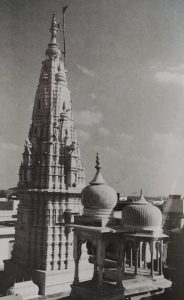 A few day’s sojourn in the Rajasthani town of Ladnun (pro- nounced Labrong), situated half- way between Jaipur and Bikaner (or Ajmer and Bikaner) and also accessible from Jodhpur by direct bus, can be recommended with- out reservation.
A few day’s sojourn in the Rajasthani town of Ladnun (pro- nounced Labrong), situated half- way between Jaipur and Bikaner (or Ajmer and Bikaner) and also accessible from Jodhpur by direct bus, can be recommended with- out reservation.
It offers, apart from some noteworthy temples and the Terapanth Vishva Bharati Instintion founded by Acharya Tulsi in 1970, a welcome change from noisy city-life. At the time of our visit, back in 1994, Ladnun was free of smoky three-wheeled motor-rickshaws; instead gaily painted horse-drawn tongas dot- ted the clean streets and lanes.
Jainism has a long history in Ladnun. Some of its temples – in all there are five Digambara and two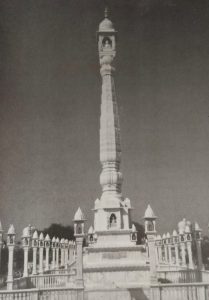 Shyetambara ones are said to date back to the tenth century; their superstructures, however, are of later centuries. Relatively many Jaina families. both Shvetambara and Digambara, are found amongst the citizens of this prosperous- looking town.
Shyetambara ones are said to date back to the tenth century; their superstructures, however, are of later centuries. Relatively many Jaina families. both Shvetambara and Digambara, are found amongst the citizens of this prosperous- looking town.
Most of the Shvetambaras are followers of the Terapanth sect which was founded by Acharya Bhikshu in 1760. There are today about 300,000 adherents of the Terapanthi community and circa 550 nuns and 150 monks.
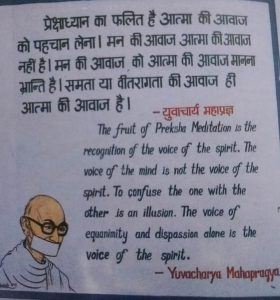 Our stay at Ladnun coincided with a gathering in the neighbouring city of Sujangarh of over twenty thousand Terapanthis and of nearly all the monks and nuns of this India-wide group within Jainism. Acharya Tulsi, their ninth spiritual leader and a native of Ladnun (bome in 1914), was to confer the acharyaship he had held for fifty-eight years on to Acharya Mahaprajna who is now their tenth pontiff.
Our stay at Ladnun coincided with a gathering in the neighbouring city of Sujangarh of over twenty thousand Terapanthis and of nearly all the monks and nuns of this India-wide group within Jainism. Acharya Tulsi, their ninth spiritual leader and a native of Ladnun (bome in 1914), was to confer the acharyaship he had held for fifty-eight years on to Acharya Mahaprajna who is now their tenth pontiff.
During Acharya Tulsi’s long acharyaship – he was eleven when he was initiated into monkhood and twenty-two when he became the youngest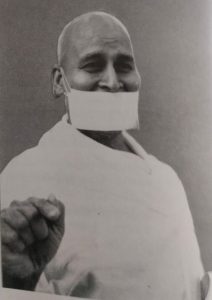 acharya ever-Ladnun acquired the distinction of growing into a seat of Jaina learning and teaching, mainly ethical teaching. It pained him to see how the desire for ever more material
acharya ever-Ladnun acquired the distinction of growing into a seat of Jaina learning and teaching, mainly ethical teaching. It pained him to see how the desire for ever more material
Loppositi tower, piercing the roof of a modern building above the sanctorum of this rwelfth-century Shantinatha Mandir. The building has an ancient underground room containing beautifully carved doorjambs and lintels, some fairly old Jina images, and a highly venerated Sarasvati, goddess of learning.
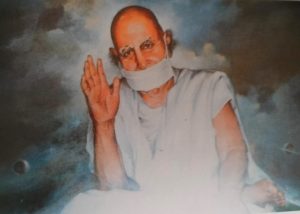 Manastambha in front of a temple built in 1935. A master-piece of modern sculpturing White marble.
Manastambha in front of a temple built in 1935. A master-piece of modern sculpturing White marble.
possessions took preference over honouring the traditional moral values. He began his crusade by instilling a new spirit, based on old Jaina virtues, into the hearts and minds of his monks and nuns without himself becoming a fundamentalist in the modern sense of the word.
Then, in 1949, two years after India gained independence, he launched his Anuvrata Movement which he wanted to be understood as a supple- ment to the Freedom Movement of earlier years: a movement for righteous living. The message of Anuvrata, addressed to lay-people, stood and still stands for a “code of conduct aimed at developing the character of an individual’ (anuvrata stands for ‘minor’ vows pertaining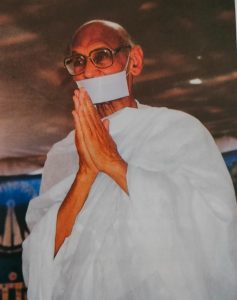 only to non-ascetics).
only to non-ascetics).
Board with a message near the ‘House of Meditation. Other sayings displayed along the campus lanes are quotations from Mahavira, the Buddha, Jesus, Mohammed, Guru Nanak, Socrates and others.
Muni Kishantal, a leading teacher of Preksha Mediation (preksha to perceive carefully and profoundly)
In the nineteen-seventies, when Jain Vishva Bharati was formally established in a sprawling area outside his birth- place Ladnun, another visionary dream of the late Gurudev Tulsi begun to bear fruit. Today it is a large and still growing complex of buildings in a setting of trees, bushes and flowers.
There are schools, facilities for study and research, a library, a centre of Ayurvedic medi- cine, a hospital, an auditorium, a printing shop, a meditation retreat, student hos- tels, guest-houses, and the like. It is a modern campus-like ashram in which foreign travellers and students, be they young or old, male or female, are wel- come and free to participate in medita- tion retreats and to study Jainism at their own pace (see appendix).
Portrait of Acharcha Tulsi, released in 1994. (Shri Gurudev Tulsi died in June 1997.)
In the course of our interview, Shri Tulsi said a number of profound things. I remember in particular, “If you don’t disappoint your de- sires, they will disappoint you”. Before we said goodbye to Shri Tulsi and his happy disciples, I questioned him about the problem of achieving happiness here on earth (…).
In effect Shri Tulsi an- swered that the body is a good ser- vant but a bad master. To be truly happy man must obey the voice of ahimsa or non-violence. Woodland Kahler (past Chairman Interna- tional Association of Vegetarians, London).
Sujangarh near Ladnun, February 18th, 1994. Yuvacharya Mahaprajna expressing thanks to the audience for accepting him as their tenth Acharya.